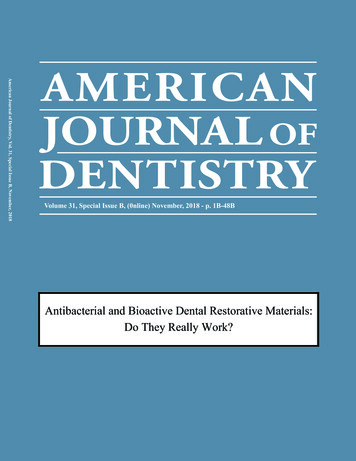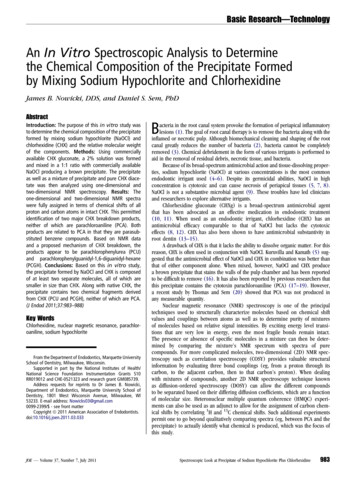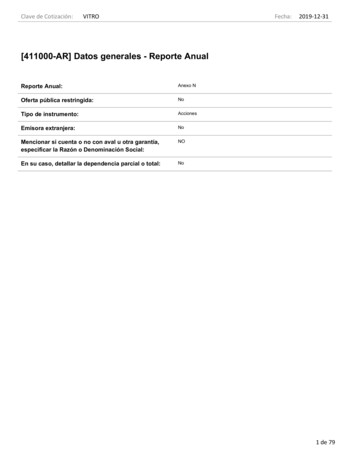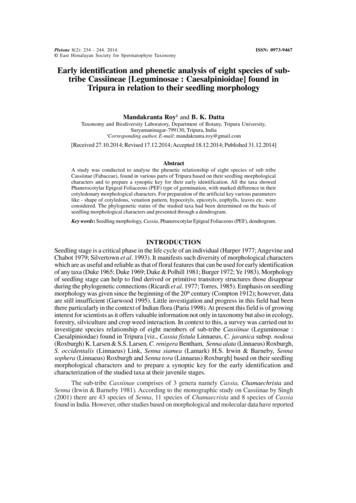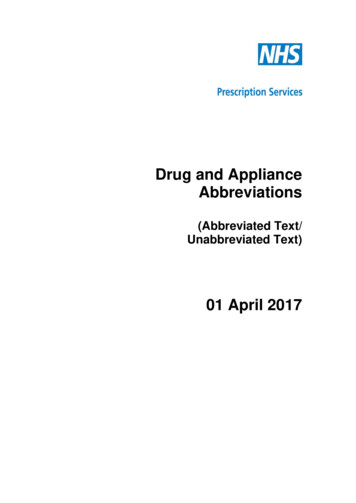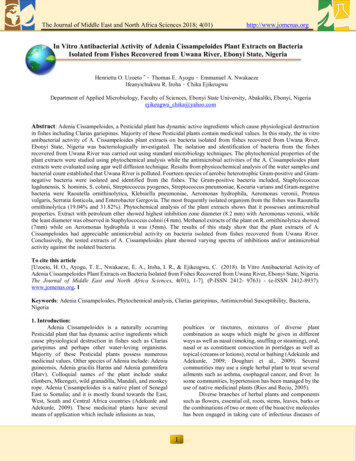
Transcription
The Journal of Middle East and North Africa Sciences 2018; 4(01)http://www.jomenas.orgIn Vitro Antibacterial Activity of Adenia Cissampeloides Plant Extracts on BacteriaIsolated from Fishes Recovered from Uwana River, Ebonyi State, NigeriaHenrietta O. Uzoeto * Thomas E. Ayogu Emmanuel A. NwakaezeIfeanyichukwu R. Iroha Chika EjikeugwuDepartment of Applied Microbiology, Faculty of Sciences, Ebonyi State University, Abakaliki, Ebonyi, Nigeriaejikeugwu chika@yahoo.comAbstract: Adenia Cissampeloides, a Pesticidal plant has dynamic active ingredients which cause physiological destructionin fishes including Clarias gariepinus. Majority of these Pesticidal plants contain medicinal values. In this study, the in vitroantibacterial activity of A. Cissampeloides plant extracts on bacteria isolated from fishes recovered from Uwana River,Ebonyi State, Nigeria was bacteriologically investigated. The isolation and identification of bacteria from the fishesrecovered from Uwana River was carried out using standard microbiology techniques. The phytochemical properties of theplant extracts were studied using phytochemical analysis while the antimicrobial activities of the A. Cissampeloides plantextracts were evaluated using agar well diffusion technique. Results from physicochemical analysis of the water samples andbacterial count established that Uwana River is polluted. Fourteen species of aerobic heterotrophic Gram-positive and Gramnegative bacteria were isolated and identified from the fishes. The Gram-positive bacteria included, Staphylococcuslugdunensis, S. hominis, S. cohnii, Streptococcus pyogenes, Streptococcus pneumoniae, Kocuria varians and Gram-negativebacteria were Raoutella ornithinolytica, Klebsiella pneumoniae, Aeromonas hydrophila, Aeromonas veronii, Proteusvulgaris, Serratia fonticola, and Enterobacter Gergovia. The most frequently isolated organism from the fishes was Raoutellaornithinolytica (19.04% and 31.82%). Phytochemical analysis of the plant extracts shows that it possesses antimicrobialproperties. Extract with petroleum ether showed highest inhibition zone diameter (8.2 mm) with Aeromonas veronii, whilethe least diameter was observed in Staphylococcus cohnii (4 mm). Methanol extracts of the plant on R. ornithinolytica showed(7mm) while on Aeromonas hydrophila it was (5mm). The results of this study show that the plant extracts of A.Cissampeloides had appreciable antimicrobial activity on bacteria isolated from fishes recovered from Uwana River.Conclusively, the tested extracts of A. Cissampeloides plant showed varying spectra of inhibitions and/or antimicrobialactivity against the isolated bacteria.To cite this article[Uzoeto, H. O., Ayogu, T. E., Nwakaeze, E. A., Iroha, I. R., & Ejikeugwu, C. (2018). In Vitro Antibacterial Activity ofAdenia Cissampeloides Plant Extracts on Bacteria Isolated from Fishes Recovered from Uwana River, Ebonyi State, Nigeria.The Journal of Middle East and North Africa Sciences, 4(01), 1-7]. (P-ISSN 2412- 9763) - (e-ISSN 2412-8937).www.jomenas.org. 1Keywords: Adenia Cissampeloides, Phytochemical analysis, Clarias gariepinus, Antimicrobial Susceptibility, Bacteria,Nigeria1. Introduction:Adenia Cissampeloides is a naturally occurringPesticidal plant that has dynamic active ingredients whichcause physiological destruction in fishes such as Clariasgariepinus and perhaps other water-loving organisms.Majority of these Pesticidal plants possess numerousmedicinal values. Other species of Adenia include: Adeniaguineensis, Adenia gracilis Harms and Adenia gummifera(Harv). Colloquial names of the plant include snakeclimbers, Mkengeti, wild granadilla, Mandali, and monkeyrope. Adenia Cissampeloides is a native plant of SenegalEast to Somalia; and it is mostly found towards the East,West, South and Central Africa countries (Adekunle andAdekunle, 2009). These medicinal plants have severalmeans of application which include infusions as teas,poultices or tinctures, mixtures of diverse plantcombination as soups which might be given in differentways as well as nasal (smoking, snuffing or steaming), oral,nasal or as constituent concoction in porridges as well astopical (creams or lotions), rectal or bathing (Adekunle andAdekunle, 2009; Doughari et al., 2009). Severalcommunities may use a single herbal plant to treat severalailments such as asthma, esophageal cancer, and fever. Insome communities, hypertension has been managed by theuse of native medicinal plants (Rios and Recio, 2005).Diverse branches of herbal plants and componentssuch as flowers, essential oil, roots, stems, leaves, barks orthe combinations of two or more of the bioactive moleculeshas been engaged in taking care of infectious diseases of1
The Journal of Middle East and North Africa Sciences 2018; 4(01)http://www.jomenas.orgCultures on TSA slant were further stored in therefrigerator at 4oC as stock for further use. These bacteriacolonies were always transferred to fresh slant to avoidcontamination every 6 weeks.the urinary tract, biliary system, respiratory system, andgastrointestinal tract as well as some skin infections(Adekunle and Adekunle, 2009; Rıos and Recio, 2005).Much recognition has been given to medicinalplants among the literate populace in the urban settlements,this may be because of the inefficacy of modern drug thatis used for management of some infectious diseases suchas gonorrhea, typhoid fever, and tuberculosis, as well asmuch cases of bacteria resistance to different antibioticsavailable in the market (Smolinski et al., 2003; Levy,1998). Bacteria present on the fish are normally indigenousof their natural environment and predisposed by the seasonand the harvesting conditions (ICMSF, 1998).Huss (1995), stated that the type and number ofpathogenic bacteria present in fish can be divided into twogroups: those bacteria (such as Clostridium botulinum,Listeria monocytogenes, Aeromonas hydrophila andVibrio species) which are commonly found in the aquaticenvironment (indigenous pathogenic bacteria of freshwater) which are present on the live fish and their presencein the final product is predictable; and non-indigenouspathogenic bacteria (such as Salmonella spp., Escherichiacoli and Staphylococcus aureus), which are normallyassociated with humans or warm-blood animals and theirfaeces, and not naturally present in fish or seafood products(Rheinheimer, 1985; Olayemi, 1994).Pesticidal plants have been employed by fishermenlocally to harvest fish in large quantity. Local herbs havebeen in use for the harvesting/catching of fish from ourlocal rivers. However, the impact of these herbs on thebacterial flora of the freshwater fishes has not beenproperly documented in recent times. In this study, the inthe vitro antibacterial activity of Adenia Cissampeloidesplant extracts on bacteria isolated from fishes recoveredfrom Uwana River, Ebonyi State, Nigeria wasbacteriologically investigated.2.3. Determination of physical parameters of the river:The following parameters: temperature, pH, specificgravity, ascorbic acid, sodium, potassium, chloride,phosphate, calcium, copper, magnesium, nitrates,ammonium, dissolved oxygen concentration (DOC) weredetermined following the method described by Al-Harbiand Uddin (2004).2.4. Heterotrophic bacterial count:The heterotrophic bacteria count of the watersamples was done using pour plate method. Ten 10-1-foldserial dilutions of the water samples were carried out andsamples were collected from the fourth tube (10-4) and thesamples were inoculated on nutrient agar and incubated for18-24 hrs. at 27oC. Plates were prepared in triplicates.Quebec colony counters with a built-in grid to simplifycounting were used.2.5. Collection of plant material:Adenia Cissampeloides plants were collected fromBotanical Garden at Nsukka, Enugu State. Authenticationof the Pesticidal plant was made by a taxonomist, Prof. S.COnyekwere of the Department of Applied Biology Science,Faculty of Science, Ebonyi State University.2.6. Maceration and extraction of plant materials:The leaves of A. Cissampeloides were air-dried atroom temperature for 2 weeks, after which it was groundto a uniform powder using an electric blender. Themethanol and petroleum ether extracts were prepared bysoaking 100 g each of the dry powdered plant material inone liter of methanol and petroleum ether at roomtemperature respectively for 36 hrs. One hundred gram(100 g) of the powdered extracts was soaked in one liter ofhot water for 36 hrs. The mixtures were filtered through aWhatman filter paper Number 42 (125 mm). The extractswere concentrated using a rotary evaporator with the waterbath set at 60 C (Ayoola et al., 2008; Deka et al., 2011).The extract was also tested for purity by plating them onnutrient agar and incubated for 24hrs at 37oC (NCCLS,1999; Biswas et al., 2002).2. Materials and methods:2.1. Collection of samples:Live fishes were collected using glass aquarium.Fifty samples of the two fishes (28 of catfish and 22 oftilapia) were examined for physical injuries and diseasesigns like ulcerations and necrotic lesions on the skinsurfaces, gills or fin rot, abdominal dropsy and pop eye.Water samples (fourteen (14) samples from each point)were also collected at different points of the river usingsterile bottle (upstream, midstream and downstream)containers.2.7. Preliminary phytochemical analysis:Determination of phytochemical constituents of thePesticidal plants was made according to the screeningprocedures in line with standard procedures (Trease andEvans, 1989; Sofowara, 1993; Harbone, 1998).2.2. Isolation of bacteria:Bacteria were obtained from different parts of thetwo fishes and also from water samples. The bacteriagrowths (colonies) were separated into diverse typesaccording to the colonial appearance (color, elevation,shape, size). The (colony types) were then streaked on TSAplate continually until distinct colonies were obtained.2.8. Screening for antimicrobial activity of plant extracts:Eighteen milliliters (18 ml) each of sterilized moltenMueller Hinton (MH) agar was poured aseptically into2
The Journal of Middle East and North Africa Sciences 2018; 4(01)http://www.jomenas.orgsterile Petri dishes and then allowed to solidify. The surfaceof the MH agar plates was then streaked with astandardized inoculum of the test bacteria that was adjustedto 0.5 McFarland turbidity standards.Thereafter, a sterilized 6 mm cork borer was used tobore 4 holes on the MH agar plate, and 3 of the holes werefilled with equal volumes of the respective plant extracts(Esimone et al., 2008). Sterilized distilled water was usedas the negative control and the positive control used wasciprofloxacin (5 µg). The plates were allowed for about 30minutes for pre-diffusion of the plant extracts, and thesewere incubated at 37oC for 24 hrs. After incubation, theinhibition zone diameters (IZD) were measured andrecorded. The IZD of each plant extracts were evaluated bysubtracting the size of the cork borer from the IZDmeasured (Onyeagba et al., 2004; Esimone et al., 2008).2.9. Determination of minimum inhibitory concentration(MIC):Cultures obtained were adjusted to 0.5 McFarlandequivalents and the inoculums were standardized to obtain1.0 105 cfu/ml. The MIC of active extracts wereevaluated using agar well diffusion method. The MICs ofall the extracts were evaluated by diluting the extracts tovarious concentrations. Decreasing concentrations ofherbal extracts were prepared in serial two-fold (10-2)dilutions using sterile distilled water. The standardizedinoculums were seeded on a prepared/solidified MH agarplates. Six (6) millimeter hole was bored using cork borer,and the diluted herbal extracts were used to fill the holes.The inoculated MH agar plates were incubated for 18-24hrs at 37oC. Plates with clear zones were observed and thedata recorded.3. Results:Table 1 shows the physicochemical properties of thewater samples. The properties include the appearance, pH,temperature, specific gravity, aerobic acid, sodium,potassium, chloride, phosphate, calcium, copper,magnesium, nitrate, and ammonium.The result obtained showed a high content ofphosphate, chloride, nitrates and other substances whichindicates pollution. The result of the heterotrophic bacteriacounts of a water sample collected from upstream,midstream and downstream is shown in Table 2. The resultobtained showed colony forming unit of bacteria between2.4 X 104, 3.4 X 104 and 5.6 X 104 respectively. The colonycount was highest at downstream.Table 2: Average Colony Forming Unit Count(Heterotrophic Bacteria Count) Analysis on WaterSamples.SampleAverage CFU CountUpstream2.4 X104 CFU/mlMidstream3.4 X104CFU/mlDownstream5.6 X104 CFU/mlKey: CFU/ml Colony Forming Unit per milliliter.Figure 1 shows the frequency of the bacteria isolatedfrom the Clarias gariepinus fish samples used for thisstudy. The results showed that more bacteria were isolatedfrom the intestines than from the gills and skins of C.gariepinus.Figure 2 shows the pictorial representations of thefrequency of the bacteria isolated from Tilapia zilliisamples used for this study. The results showed that inTilapia zillii, bacteria were isolated more from the skinthan gills and intestine.0.06 0.00Ammonium0.11 0.000.16 0.014.20 0.08DOC(mg/L)4.50 0.124.60 0.16Magnesium (mg/L)Nitrates (mg/L)1.93 0.052.67 0.122.70 0.160.38 0.370.60 0.080.58 0.02Calcium (mg/L)1213.33 14.48 1173.33 20.55Copper (mg/L)1208.33 6.2425.23 0.2928.07 0.7728.57 0.17Chloride (mg/L)Phosphate (mg/L)4.23 0.2310.47 0.21Potassium (mg/L)10.43 0.2581.33 1.2575.27 0.3475.43 0.243.75 0.035.40 0.165.20 0.16Ascorbic acid (mg/L)184.07 0.34 Sodium (mg/L)175.73 0.87Specific gravity17.53 0.266.03 0.12115.87 0.1215.87 0.1224.4 0.94 0 C25.3 0.69 0 C26.1 1.16 0 C TempPH6.56.56.5AppearanceBrownish& clearBrownish& clearBrownish& clearBCAWater SampleTable 1: Average Physicochemical Parameters of theWater Samples.Figure 1. Frequency of Bacteria Isol
ejikeugwu_chika@yahoo.com Abstract: Adenia Cissampeloides, a Pesticidal plant has dynamic active ingredients which cause physiological destruction in fishes including Clarias gariepinus. Majority of these Pesticidal plants contain medicinal values. In this study, the in vitro antibacterial activity of A. Cissampeloides plant extracts on bacteria isolated from fishes recovered from Uwana River .

